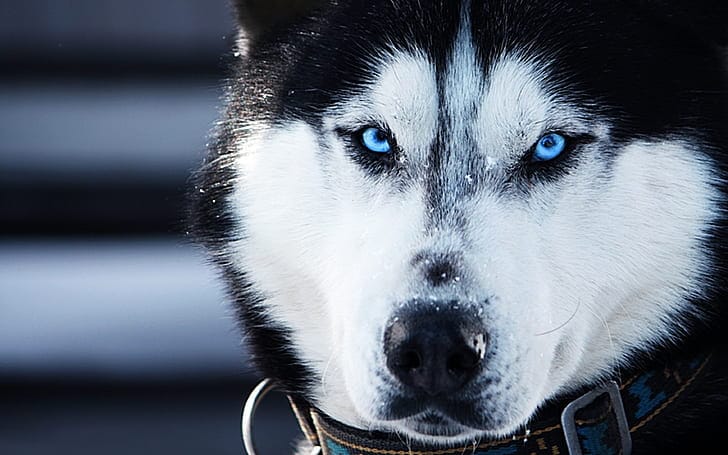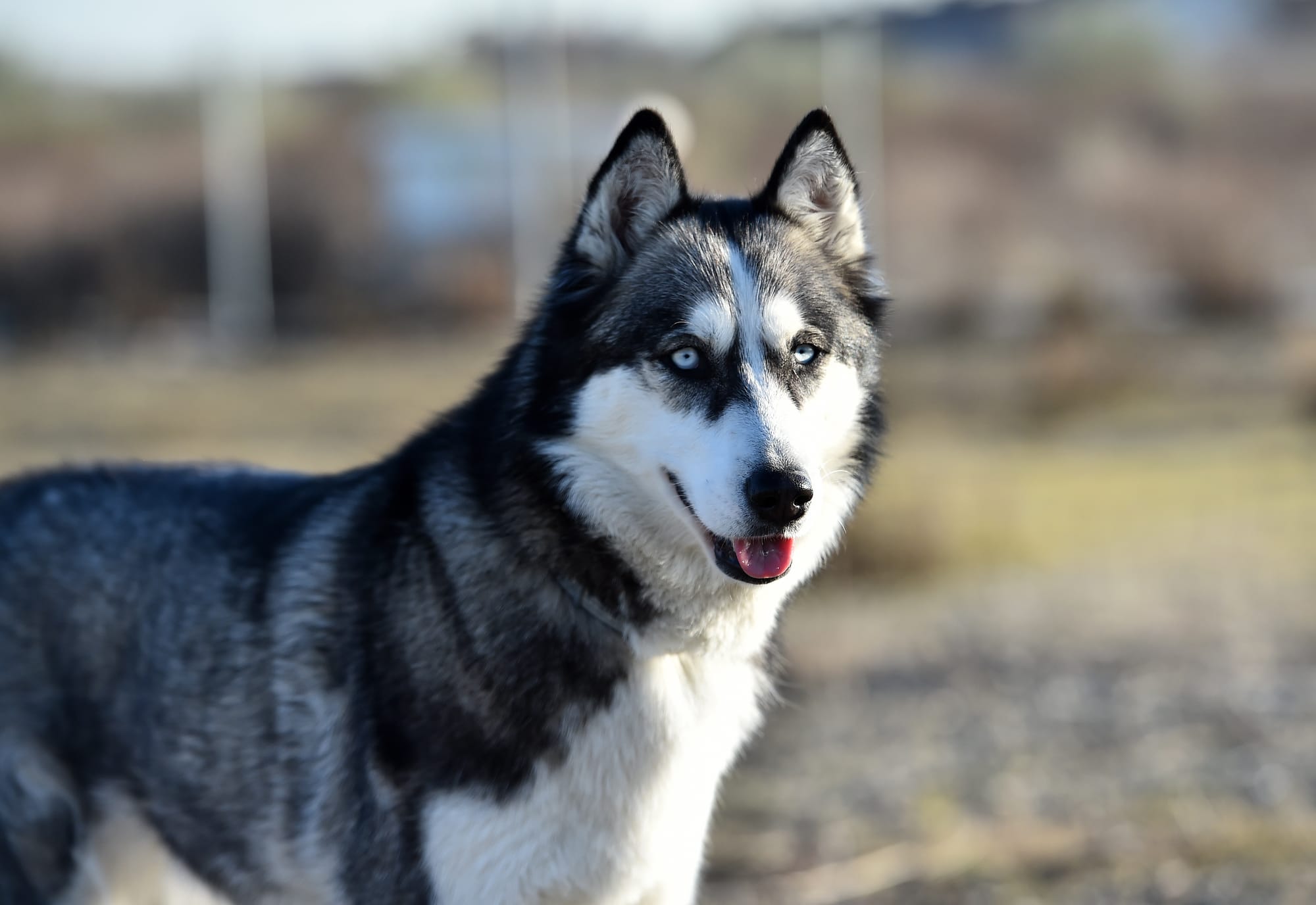Alaskan Malamutes are a popular breed of dog known for their strength, endurance, and loyalty. These dogs have a thick, double-layered coat that keeps them warm in cold weather, and they come in a variety of colors, including black, gray, and white. One question that many people have about Alaskan Malamutes is whether or not they can have blue eyes.

The answer to this question is yes, Alaskan Malamutes can have blue eyes. However, it is not a common trait for this breed. Most Alaskan Malamutes have brown eyes, but some may have blue eyes or even one blue eye and one brown eye. The color of an Alaskan Malamute's eyes is determined by genetics, and it is possible for two brown-eyed Alaskan Malamutes to have a blue-eyed puppy if both parents carry the recessive gene for blue eyes.
Alaskan Malamute Eye Color Genetics
Genetic Determinants
Eye color in Alaskan Malamutes is determined by genetics. The genes that control eye color are located on chromosome 18 in dogs. These genes control the production of melanin, which is the pigment that gives color to the eyes, skin, and hair. The amount and type of melanin produced determine the color of the eyes.
There are two types of melanin: eumelanin and pheomelanin. Eumelanin is responsible for dark colors such as brown and black, while pheomelanin is responsible for lighter colors such as yellow and red. The genes that control eye color in Alaskan Malamutes are complex and can produce a wide variety of colors, including blue.

Common Eye Colors
The most common eye colors in Alaskan Malamutes are brown and amber. These colors are the result of a dominant gene that produces eumelanin. Some Alaskan Malamutes may have one blue eye and one brown or amber eye, which is called heterochromia. This is also the result of genetics and is not uncommon in the breed.
Blue eyes in Alaskan Malamutes are caused by a recessive gene that produces little to no melanin in the iris. This gene is rare in the breed and is not considered a desirable trait by breed standards. Alaskan Malamutes with blue eyes may be more prone to eye problems such as cataracts and sun damage, as they have less protection from UV rays.
In conclusion, eye color in Alaskan Malamutes is determined by genetics and can produce a wide variety of colors. Brown and amber are the most common eye colors in the breed, while blue eyes are rare and not considered desirable by breed standards.
Occurrence of Blue Eyes in Alaskan Malamutes
Blue Eyes Rarity
Alaskan Malamutes are known for their striking and captivating eyes, which come in a range of colors, including brown, amber, and blue. While blue eyes are not uncommon in some dog breeds, they are relatively rare in Alaskan Malamutes. According to the American Kennel Club (AKC), blue eyes occur in less than 10% of the breed.
It is important to note that blue eyes in Alaskan Malamutes do not necessarily indicate a lack of breed purity. This is because the gene that causes blue eyes is not linked to any specific breed. Instead, it is a simple recessive trait that can occur in any breed, including Alaskan Malamutes.
Health Implications
While blue eyes in Alaskan Malamutes may be aesthetically pleasing, they can also be a sign of certain health issues. Some Malamutes with blue eyes may suffer from a condition called iris hypoplasia, which is a lack of pigment in the iris. This can cause sensitivity to light and an increased risk of eye problems such as cataracts and glaucoma.
Additionally, Malamutes with blue eyes may be more prone to deafness, as the gene that causes blue eyes is also linked to deafness in some breeds. However, it is important to note that not all Malamutes with blue eyes are deaf, and not all deaf Malamutes have blue eyes.
In conclusion, while blue eyes are rare in Alaskan Malamutes, they can occur and are not necessarily a sign of impurity. However, Malamute owners should be aware of the potential health implications associated with blue eyes and should take appropriate measures to ensure their dog's health and well-being.
Breed Standards for Alaskan Malamutes
American Kennel Club Standards
According to the American Kennel Club (AKC), the Alaskan Malamute is a powerful and substantially built dog with a deep chest and strong, well-muscled body. The breed is known for its thick, double coat, which provides insulation in cold weather. The AKC breed standard for Alaskan Malamutes requires that the eyes be brown in color. Blue eyes are considered a disqualification in the show ring.

The AKC also sets standards for other physical characteristics of the Alaskan Malamute, such as height and weight. For example, male Alaskan Malamutes should be between 25 and 27 inches tall at the shoulder and weigh between 85 and 100 pounds. Female Alaskan Malamutes should be between 23 and 25 inches tall at the shoulder and weigh between 75 and 90 pounds.
Other Kennel Clubs
Other kennel clubs, such as the United Kennel Club (UKC) and the Canadian Kennel Club (CKC), also have standards for the Alaskan Malamute breed. The UKC breed standard for Alaskan Malamutes is similar to the AKC standard, with brown eyes being the only acceptable color. The CKC standard allows for brown or amber eyes, but again, blue eyes are considered a disqualification.
It is important for breeders and owners of Alaskan Malamutes to be familiar with the standards set by their respective kennel clubs. These standards help to maintain the integrity of the breed and ensure that Alaskan Malamutes continue to exhibit the physical and behavioral traits that have made them such beloved companions for centuries.
Distinguishing Alaskan Malamutes from Similar Breeds
Alaskan Malamutes are a large and powerful breed of dog that are often confused with other similar breeds such as the Siberian Husky and the Alaskan Husky. However, there are a few key distinguishing features that set the Alaskan Malamute apart from these other breeds.
One of the most notable differences is their size. Alaskan Malamutes are typically larger and more heavily built than Siberian Huskies and Alaskan Huskies, with males weighing up to 85 pounds and females weighing up to 75 pounds. They also have a broader head and chest, as well as a thicker coat.
Another distinguishing feature of Alaskan Malamutes is their eye color. While some Alaskan Malamutes may have blue eyes, it is not a common trait in the breed. In fact, blue eyes are more commonly seen in Siberian Huskies and other breeds such as the Australian Shepherd. Alaskan Malamutes are more likely to have brown or amber eyes, although some may have one blue eye and one brown eye.
In addition to their physical appearance, Alaskan Malamutes also have a unique personality. They are known for their loyalty, intelligence, and strong work ethic. They were originally bred as sled dogs and have a strong desire to work and be active. This makes them a great choice for people who enjoy outdoor activities such as hiking, camping, and skiing.
Overall, while there are some similarities between Alaskan Malamutes and other breeds such as Siberian Huskies and Alaskan Huskies, there are also several key differences that set them apart. By understanding these differences, potential owners can make an informed decision about whether an Alaskan Malamute is the right breed for them.
Selecting an Alaskan Malamute
When selecting an Alaskan Malamute, it is important to consider a few key factors. These factors will help ensure that you find a healthy and well-bred dog that is right for you and your family.

Breeder Considerations
One of the most important factors to consider when selecting an Alaskan Malamute is the breeder. It is important to find a reputable breeder who takes the time to properly socialize and care for their puppies. A good breeder will also be knowledgeable about the breed and will be able to answer any questions you may have.
When looking for a breeder, it is a good idea to ask for references and to do your own research. You can also check with breed clubs or organizations to find reputable breeders in your area. It is important to avoid puppy mills or backyard breeders, as these breeders often prioritize profit over the health and well-being of their dogs.
Health Screening
Another important factor to consider when selecting an Alaskan Malamute is health screening. This breed is prone to certain health issues, such as hip dysplasia and eye problems. It is important to find a breeder who performs health screenings on their breeding dogs to help reduce the risk of these issues being passed down to their puppies.
Some of the health screenings that should be performed on Alaskan Malamutes include hip and elbow evaluations, eye exams, and cardiac exams. It is important to ask the breeder for documentation of these screenings before purchasing a puppy.
In addition to finding a breeder who performs health screenings, it is also important to provide your Alaskan Malamute with proper veterinary care throughout their life. This includes regular check-ups, vaccinations, and preventative care.
By considering these factors when selecting an Alaskan Malamute, you can help ensure that you find a healthy and well-bred dog that will be a great addition to your family.
The Popularity of Blue-Eyed Malamutes
Blue-eyed Malamutes have undeniably become a sensation within the pet community in the United Kingdom. Their captivating gaze, adorned with shades of blue, has propelled these majestic dogs to new heights of popularity, making them stand out among other canine breeds.
Influence on Popularity in the Pet Community
The enchanting allure of blue eyes in Alaskan Malamutes has a profound impact on their popularity. Dog enthusiasts and potential pet owners are often drawn to the unique and mesmerizing aesthetic that blue-eyed Malamutes bring to the table. Social media platforms, dog shows, and local communities are buzzing with admiration for these captivating canines.
Aesthetic Appeal and Its Impact on Adoption Rates
The aesthetic appeal of blue-eyed Malamutes significantly influences adoption rates. Potential owners are often captivated by the distinctive look that blue eyes impart to these arctic dogs. As a result, shelters and breeders find that Malamutes with blue eyes are frequently sought after, contributing to their increased adoption rates.
In the UK, where dog lovers appreciate diversity in breeds, the distinctive appearance of blue-eyed Malamutes adds a touch of uniqueness to the local pet community. Their popularity is not merely limited to physical attributes but also extends to the charm and character these dogs bring into the lives of their owners.
Whether seen strolling through local parks or featured on social media accounts, blue-eyed Malamutes have become ambassadors of the breed's unique beauty. This surge in popularity not only benefits individual dogs but also sheds light on the significance of responsible ownership and understanding the specific needs associated with this eye-catching trait.

In summary, the popularity of blue-eyed Malamutes in the United Kingdom reflects a shared appreciation for the beauty and uniqueness they bring to the world of pets. Their enchanting gaze has captured the hearts of many, fostering a growing community of proud blue-eyed Malamute owners across the country.
Conclusion
In conclusion, the presence of blue eyes in Alaskan Malamutes adds an extra layer of charm to these already captivating dogs. Responsible ownership, proper care, and understanding of the unique traits associated with blue eyes contribute to a fulfilling relationship between owners and their Malamutes.
Frequently Asked Questions
- Is it common for Alaskan Malamutes to have blue eyes?
- No, it is not common for Alaskan Malamutes to have blue eyes. Blue eyes are a rare occurrence in this breed and are considered a fault by the American Kennel Club (AKC) breed standard.
- What are the typical eye colors for Alaskan Malamutes?
- The typical eye colors for Alaskan Malamutes are brown and amber. Some may have eyes that are a combination of both colors. Blue eyes are not a typical eye color for this breed.
- How can one distinguish between a Husky and an Alaskan Malamute?
- Huskies and Alaskan Malamutes may look similar, but there are some key differences. Alaskan Malamutes are typically larger and heavier than Huskies and have a broader head and chest. Alaskan Malamutes also have a thicker and longer coat than Huskies.
- What are the rarest coat colors for Alaskan Malamutes?
- The rarest coat colors for Alaskan Malamutes are white and solid black. These colors are not recognized by the AKC breed standard and are considered a fault.
- Which dog breeds are known for having blue eyes?
Dog breeds that are known for having blue eyes include Siberian Huskies, Australian Shepherds, and Border Collies.
- Are there any eye color variations in Alaskan Malamutes other than the usual?
No, there are no other eye color variations in Alaskan Malamutes other than brown, amber, or a combination of both. Blue eyes are not a typical eye color for this breed and are considered a fault by the AKC breed standard.